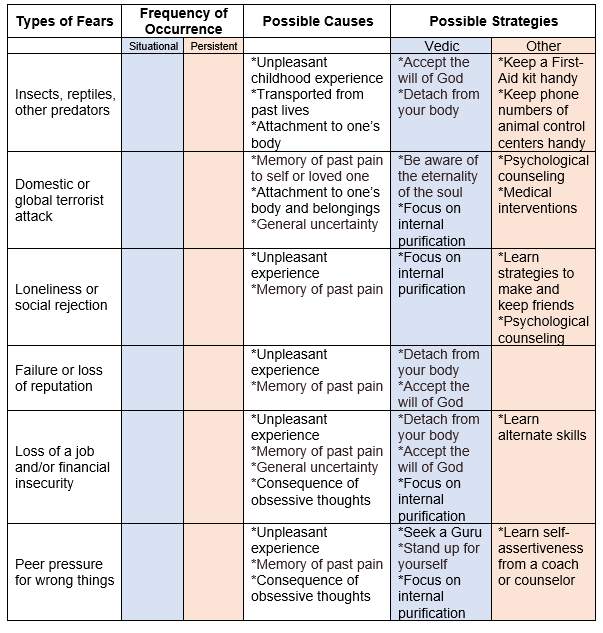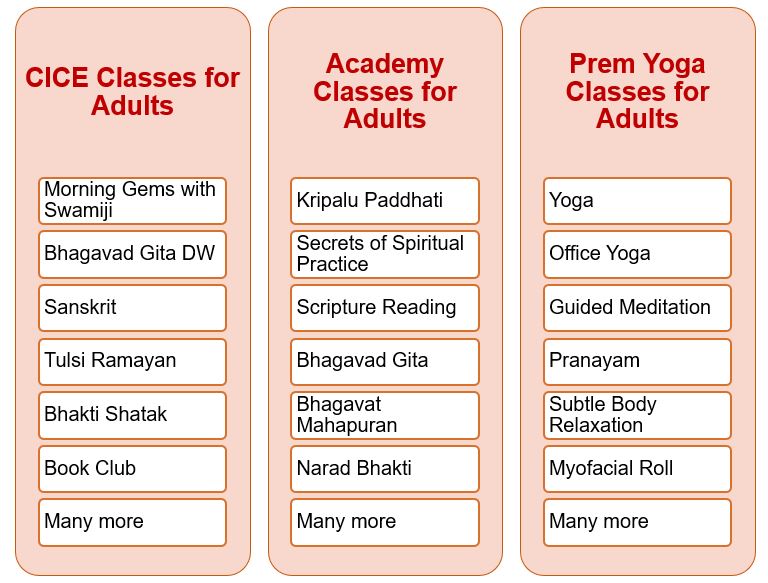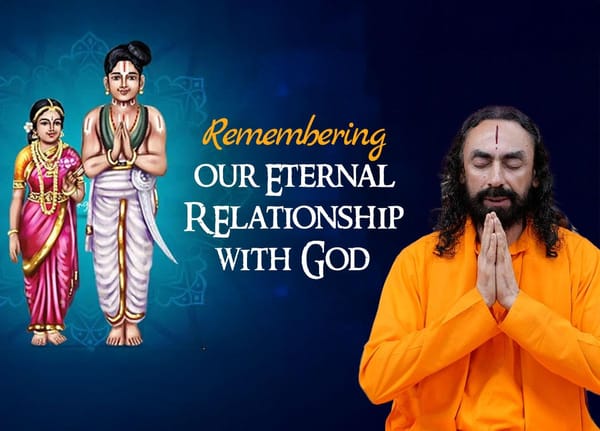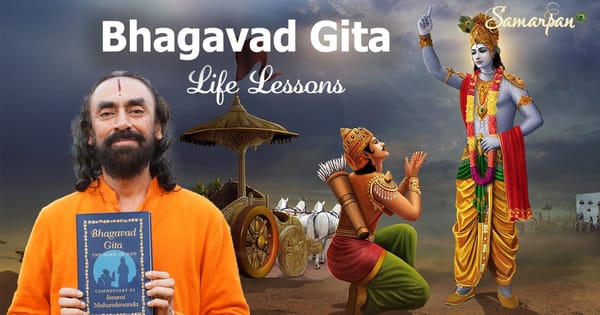
From the Editor’s Desk
We all have experienced many different types of fears from childhood to adulthood but letting go of fear is challenging. While some types of fears are healthy and garner us into action, others can be debilitating and paralyze us or deplete our internal resources. Swami Mukundananda ji has explained the causes of different types of fears and provided us with strategies to overcome fears. Let's utilize the Vedic knowledge (i.e., tatvagyan) to first understand and then let go of our fears.

Vedic Wisdom & Application
Challenge of the Month
Letting Go of Fear
Reflection Questions
- What are the different types of fears?
- What are the causes of fear?
- What are the strategies for overcoming fear?
What Are the Different Types of Fears?
Fear is a deep-seated emotion that all of us experience in response to a real or perceived threat of harm to one’s physical, emotional or psychological well-being. It is an instinctive emotion that sends alert signals to the brain and we react in a pattern of fight, flight, freeze or face. Our natural reaction is one that we believe will keep the body safe from external sources of harm. From this perspective, fear serves an important function. It protects us from harm.
Most types of fears are common and considered normal, for example, being bitten by insects or reptiles, being attacked by a predator, being harmed by extremists, being alone or socially rejected, any form of failure, loss of reputation, loss of a job, financial insecurity, peer pressure to do the wrong things, the threat of severe weather (e.g., hail, tornado, hurricane, flood, blizzard), death from disease or accident, dying alone in an undignified state, death of a loved one, etc.
Some fears are situational and last until the threat of danger is averted. For example, a scary reptile turns the other way, a person is not fired from the job or is fired but finds a new job, or the severe weather threat is pulled back. However, other types of fears are more persistent and intense and have the potential to debilitate a person from leading a regular life (e.g., certain phobias, PTSD, specific disorders). Even those who follow the devotional path, are frequently afraid of spiritual downfall. For example, knowledge of the concept of karma and awareness that we must pay for the countless sins from endless lifetimes makes us fear the consequences in this life.
Of all the different types of fears, the one that is common to all life forms is abhiniveśh. In his lecture series on Patanjali Yoga Sutras, Swamiji has described abhiniveśh as the fear of death or the instinctive urge to survive at all costs. Even when people live a miserable life, they desire to live rather than die. Swamiji explains that fear of death is a trait of the material intellect because we identify with our body, forgetting that the soul is immortal. So, what makes us scared or afraid of anything?
What Are the Causes of Fear?
Swamiji has explained many different causes of fear including unpleasant childhood experiences that register into the subconscious, and others that are transported from our past lives (e.g., claustrophobia). Some fears are consequences of our own obsessive thought patterns, for example, excessive anxiety about failure. In the commentary in Bhagavad Gita (12.15), Swamiji says that the memories of past pain and apprehensions of future pain torment the mind more than the present pain. In many cases, a general sense of uncertainty and unpredictability about how long a scary situation will last, or what the outcome will be, increases the level of fear.
When our mind is attached to a belief-based outcome, the belief leads to fear (e.g., “I need to succeed in order to keep my parents happy.”). Similarly, our belief in the scriptural knowledge of the outcome of our karmas may lead to fear of being subjected to hellish conditions that would cause physical pain and mental distress.
Fear is the symptom of the probability of losing the object of attachment. “Attachment to wealth leads to the dread of impoverishment, attachment to social prestige causes fear of infamy, attachment to vice leads to anxiety about the consequences of sin, attachment to bodily comfort causes the fear of ill-health, and so on” (Bhagavad Gita 16.1 commentary). Similarly, images of devastation from hurricanes or tornadoes increase the fear of losing everything that makes us feel secure, or of being injured from such natural calamities.
We are attached to our body, thus are afraid of experiencing pain. We all fear death because we are attached to, and identify with the body, not the soul. We know that whoever has life, will perish, yet we are unable to prepare for death. How can we let go of our fears?
What Are the Strategies for Overcoming Fear?
People who experience intense fears that paralyze their lifestyle may frequently seek a combination of therapies like psychological counseling, mindfulness training, or even medical interventions. For some types of fears (e.g., reptiles or predators), a simple thing like keeping the phone numbers of animal control centers or pest control companies, or having a First-Aid kit handy, may relieve some fear. We can even deal with certain types of fear (e.g., financial insecurity) by training for alternate skill sets.
In cases of persistent fears associated with misguided peer pressure, we may think about the option of assertiveness training. If we live in a region associated with severe weather threats (e.g., hail, tornado, hurricane, flood, blizzard), we should expect the possibility of destruction to the home and property and prepare for emergencies. The purpose of each of these is to increase the sense of well-being and eliminate or decrease distress.
The Vedic perspective is different. It suggests that all souls under maya have five mental afflictions including Avidya (i.e., ignorance), Asmitha (i.e., false pride), Abinivesh (i.e., fear of death), Raag (i.e., attachment), and Dvesh (i.e., hatred). Our attachment to external objects including our body is what increases our fear. The moment we become detached, we become fearless.
Strategy # 1: Develop Detachment from Objects and People. Shree Krishna tells Arjun that devotees who are free from attachment are also in harmony with the will of God. Hence, they experience neither fear nor anxiety associated with losing anything (Bhagavad Gita 12.15). This also includes detachment from one’s own body.
Strategy # 2: Accept the Will of God. In everything we do, we should focus on doing our best but accept any outcome that comes our way in accordance with the will of God. Swamiji teaches us to develop the mindset, “I do not want pain but if God wants me to experience pain, I will accept it for His pleasure.” If anxious or fearful of the outcome of bad karmas, we need to contemplate to accept that there is always justice in God’s realm. "I will have to face the consequences, but I can seek the shelter of a divine Guru who can help me to accept the will of God." We must also have the faith that a Guru will never abandon us if we follow the prescribed path as taught by the Guru.
Strategy # 3: Take Fear as an Impetus for Internal Purification (Bhagavad Gita 2.56). We have only one mind. We can either brood over miseries and sources of fear or contemplate on the divine. Whether we fear loneliness, a terrorist attack, misdirected peer pressure, financial insecurity, or any other type of fear, brooding usually pulls us down from the transcendental level whereas focusing on God purifies the soul. When fearful of something, inspire yourself to let go of the fear by attaching the mind to God and purifying the soul. Daily meditation on God’s names, virtues, leelas or pastimes, abodes, and saints will help to overcome fear. Also, one of the six aspects of surrender to God is to have complete faith that God and Guru are our witnesses and protectors. If you do not have a Guru, it is a good idea to seek a Brahmanishta and Shrotriya Guru who can guide us toward true knowledge and teach us to let go of fear.
Strategy # 4: Awareness of the Eternality of the Soul. It is inevitable that those who have taken birth, will someday die as well. So, why fear the inevitable? Shree Krishna explains to Arjun (Bhagavad Gita 2.27):
जातस्य हि ध्रुवो मृत्युर्ध्रुवं जन्म मृतस्य च |
तस्मादपरिहार्येऽर्थे न त्वं शोचितुमर्हसि ||27||
jātasya hi dhruvo mṛityur dhruvaṁ janma mṛitasya cha
tasmād aparihārye ’rthe na tvaṁ śhochitum arhasi
Death is certain for one who has been born, and rebirth is inevitable for one who has died. Therefore, you should not lament over the inevitable (BG 2.27).
Swamiji explains that even in a single lifetime, we go through so many changes in our physical body as we developmentally progress from infancy to old age. When the body metamorphoses in such unique ways in a single life, why do we fear losing the body upon death? If we truly believed that we are the soul, we would not fear death because the soul, like God, is eternal.

Tools for Your Personal Growth
This tool may allow you to better understand and let go of your fear. First, identify the pattern by marking an “x” on whether the fear is situational (temporary) or persistent (more serious). Second, understand the cause to know the possible source of fear. Third, use the best strategies to let go of fear based on what best suits your personality and preference.

A "strategies" sheet is available for you. You can keep a printed or e-copy to assess the pattern of fear and find related strategies that might be useful to you.

Love to Hear from You
- How did you apply the Vedic Wisdom?
- What challenges did you experience in the process?
Please share your comments under “Join the Discussion” below.

Gems of Wisdom from Swamiji
Here are some YouTube video titles and related links where Swamiji describes the importance of letting go of fears.
- Having Complete Faith that God is Protecting Us | Part 3 - 6 Conditions for Surrender
- Powerful Inspirational Success Story | Overcoming Fear Of Failures
- The 1 SECRET to Overcome the Fear of Death



Hold Your Breath! Check out Upcoming Events
We are very excited to inform you about a dynamite event this month!
We have all heard Swamiji describe the magical experiences in Ayodhaya when Lord Ram was born. The Lord appeared in his four-armed opulent form but upon mother Kaushilya’s request, the Lord transformed into a little baby. The Lord does not need to take birth to kill demons. Merely thinking about annihilating a demon will produce the outcome. The Lord takes birth in the human form to instill devotion in people.
We invite you to dive into devotion associated with Lord Ram’s birth as we celebrate Chaitra Navaratri and Ram Navami at the Radha Krishna Temple of Dallas, the Headquarters of JKYog. Like all other festivals, this too will be grand and inspire the community to experience the kindred spirit. Join us in-person or online!
We have a 10-day program starting with Chaitra Navaratri (April 12th to 21st) leading up to Ram Navami (April 21st)! Every day there will be a cultural program, Ramayan narration, Aarti and a special Navaratri event. Additionally, there will be a Durgashtami Havan on April 20th and Shree Ram Abhishek and Swamiji’s video lecture on Ram Navami.
There will be opportunities to participate. Check out the details!

Voices from the Global Community
We introduce you to a member of our global community who has been impacted by the scriptural knowledge as taught and disseminated by Swamiji. This month, we feature Shalini Gurnani. Shalini ji lives in NY with her husband and children. Her son is a College Junior and daughter in High School. She is a Registered Nurse who works at a hospital.
Shalini ji was graced with Swamiji’s darshan a few years ago during his discourse at the Asa Mai temple in Hicksville, Long Island. She was inspired to have a one-to-one conversation with Swamiji. Soon after, Shalini ji got involved in many different sevas which was the beginning of her association with the JKYog family. Her involvement added new meaning and purpose to her life. Shalini ji is very grateful and blessed to have Swamiji as her Guru. Please watch the video where she describes how she benefitted from Swamiji’s teachings.
We invite you to share your inspirations and success stories with us at secretary@jkyog.org.

JKYog Transforming Communities
In this feature, we would like to share the amazing activities and news about programs conducted by JKYog USA.


Glimpses of Past Events
Want a glimpse of some of our events? JKYog had a very memorable March as we celebrated several dynamite events. We share a few beautiful glimpses with you.










